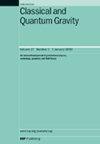用非平面偏心波形模型重访GW150914
IF 3.7
3区 物理与天体物理
Q2 ASTRONOMY & ASTROPHYSICS
引用次数: 0
摘要
LIGO合作项目GW150914首次直接探测到引力波,标志着天文学一个激动人心的新时代的开始,使人们能够通过一个新的信使来研究宇宙。从那时起,随着越来越复杂的检测、分析和解释信号技术的发展,该领域迅速发展。在本文中,我们重新审视了GW150914,使用EOB形式中开发的波形模型对其源参数进行了更新估计,能够描述一般非圆形,非平面双星的引力波发射。我们对信号及其特性进行了全面的分析,考虑并对比了信号源的各种情况:从最简单的对齐自旋准圆(QC)双黑洞(BBH)合并,到更复杂的情况,包括进动、偏心或两者兼而有之。不出所料,我们发现信号与QC一致(15 Hz时e < 0.08),缓慢旋转BBH合并,事后验证了相当多的工作。这是第一次使用包含偏心和进动的吸气-合并-环落模型进行分析。本文章由计算机程序翻译,如有差异,请以英文原文为准。
Revisiting GW150914 with a non-planar, eccentric waveform model
The first direct detection of gravitational waves by the LIGO collaboration, GW150914, marked the start of a new exciting era in astronomy, enabling the study of the Universe through a new messenger. Since then, the field has grown rapidly, with the development of increasingly more sophisticated techniques to detect, analyze and interpret the signals. In this paper we revisit GW150914, presenting updated estimates of its source parameters using a waveform model developed within the EOB formalism, able to describe gravitational-wave emission from generic non-circular, non-planar binaries. We provide a comprehensive analysis of the signal and its properties, considering and contrasting various scenarios for the source: from the simplest, aligned-spin quasi-circular (QC) binary black hole (BBH) merger, to more complex scenarios, including precession, eccentricity or both. Unsurprisingly, we find that the signal is consistent with a QC (e < 0.08 at 15 Hz), slowly spinning BBH merger, a-posteriori validating a considerable body of works. This is the first analysis performed with an inspiral-merger-ringdown model containing both eccentricity and precession.
求助全文
通过发布文献求助,成功后即可免费获取论文全文。
去求助
来源期刊

Classical and Quantum Gravity
物理-天文与天体物理
CiteScore
7.00
自引率
8.60%
发文量
301
审稿时长
2-4 weeks
期刊介绍:
Classical and Quantum Gravity is an established journal for physicists, mathematicians and cosmologists in the fields of gravitation and the theory of spacetime. The journal is now the acknowledged world leader in classical relativity and all areas of quantum gravity.
 求助内容:
求助内容: 应助结果提醒方式:
应助结果提醒方式:


